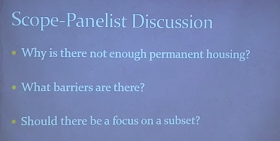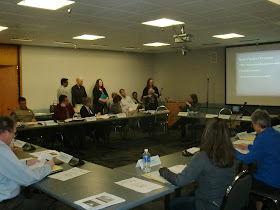 |
| Progress Report on Salem City Council's 2015 Goals |
Revised: December 2018
By Sarah Owens and Michael Livingson
[Originally posted under the title, "MWHITF: Next Steps"]
Monday, February 22, 2016, the Salem City Council will receive a report on what's been done toward reaching their goal of creating a well-planned community. As shown above, the first meeting of the Mid-Willamette Homeless Initiative is being reported as a sign of progress toward that goal.
According to the
Statesman Journal, the task force will, at its next meeting, "delve into the housing market and development opportunities." And, by the third or fourth meeting, they might start looking at recommendations. (Co-Chair Carlson has twice said that what she expects ultimately from the task force is a list of strong recommendations).
So things would appear to be moving rather quickly. But what are they moving toward, exactly?
In January, the Mayor told the
Statesman Journal that she wanted the task force to "identify areas, projects or programs that aren't working as effectively as they need to be, stop any waste that is occurring, and redirect those funds and those activities." However, her co-chair Janet
Carlson later indicated the task force would
not be looking at program effectiveness. Based on her questions at the first meeting, and the short shrift given the "
Services Inventory" portion of the agenda, it would indeed appear that Carlson expects to focus on housing and housing funding, not services.
Here's what the other members of the task force said they wanted to see happen:
 |
| Jennifer Wheeler |
Co-Chair Wheeler said she "would like to meet some of the community members who are actually doing the work and find out what services are being provided, and maybe where the holes are, the gaps are that need to be filled." She expressed concern about the "invisible homeless" in rural areas whom she wants to bring "into the light." She was "very anxious to find out about services and how to connect people to those services."
 |
| Warren Bednarz |
Councilor Bednarz has taken the issue "to heart", spent a lot of time educating himself and feels that's the first thing community leaders need to do -- educate themselves, to know what services are out there, what can be combined, coordinated, etc., so "people don't have to scramble" to find them and so that "efforts can be coordinated." What he wants out of the initiative is "an action plan, not a discussion, not a report." He would also like to have a homeless person or a home-insecure individual(s) on or closely allied with the task force because he thinks their knowledge/experience/insight would be helpful.
 |
| Steve Bobb, Sr. |
Steve Bobb, a Marine Corps Vietnam War veteran and formerly on the Council of the Confederated Tribes of the Grand Ronde, joined the task force because he's familiar with veterans who are "on the streets and the issues that put them there." He's been on a few boards "where they have meeting after meeting, and after a little while, that tends to make me a little crazy" and he hopes the task force will be different and actually help people.
 |
| Bruce Bailey |
Bruce Bailey, Union Gospel Mission, also wanted to see the Initiative result in an action plan. He would like the task force to focus not on ending homelessness, but on breaking the cycle of homelessness.
 |
| Irma Oliveros |
Irma Oliveros, homeless liason for the Salem-Keizer School District who also lives in Polk County, sees a steady increase in the number of homeless families and students. Although she is "not sure homelessness can be ended", she "sure would like to see it minimized."
 |
| Jon Reeves |
Jon Reeves, Director of the Mid-Willamette Valley Community Action Agency, says we need "community solutions." Referring to the 70+ members of the audience, "I don't know that I've ever seen this much interest in helping the homeless finding stable housing and self-sufficiency."
 |
| Verena Wessel |
Verena Wessel, serving as a mere citizen (with 15 years experience in delivering social services to homeless individuals) says "We've got to get some traction. It's not going to get any better."
 |
| Chief Moore |
|
SPD Chief Moore is also concerned about the "invisible homeless" and wants to see better coordination of services.
 |
| Sheriff Myers |
Sheriff Myers feels the criminal justice system is not the right place for people who are homeless, but that's typically where they end up. So he wants the task force to help him "do right by these people" who typically have mental health/substance abuse issues.
 |
| Judge Leith |
Judge Leith, who presides over the Marion County Drug Court, believes homelessness is of "truly primary importance to the community."
On hearing comments like these, one might expect the task force to have a conversation about pooling a few thousand dollars for a consultant to give them something like a "Homeless Needs Assessment" or other serious examination of area programs and services. Like the Chair said at the first meeting, they "
need some very basic information", some objective basis for evaluating program and project effectiveness, gaps in services, duplication, etc. The providers themselves obviously cannot do it, nor can staff, given their other duties. But it
would seem to be something that the task force needs for their work.
2018 Update: The task force did not ultimately attempt to evaluate program and project effectiveness, gaps in services, duplication, etc. But, in 2018, Salem and Marion County, along with Keizer, Monmouth and Independence, did pool their resources and hired someone to conduct the necessary research and analysis. Unfortunately, she quit after ten months. For details, see "
Homeless Program Coordinator Calls It Quits" (2 November 2018).

























